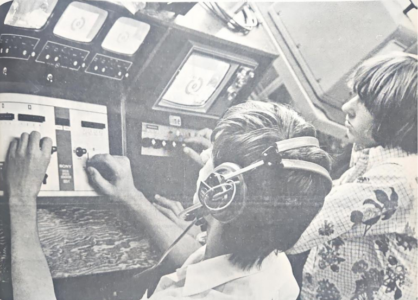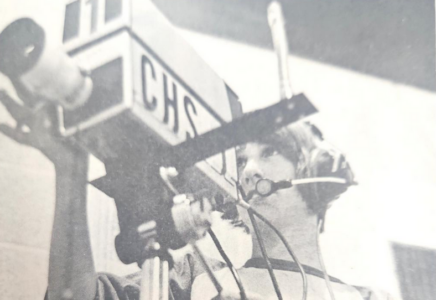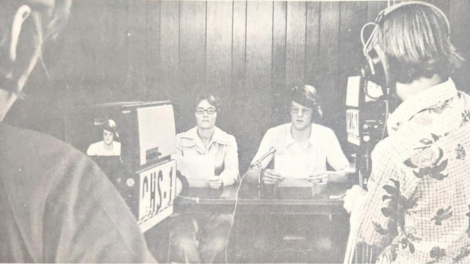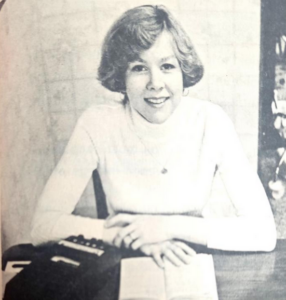Cathedral High’s on the air

JOHN HOFMEISTER, wearing headset, works with the Special Effects Generator (SEG), while Tom Niehoff watches the audio level. The three small TV monitors are used to view camera shots, one for each of Cathedral’s two cameras, and one for use with the SEG. The shot to be used is then “punched up” onto the larger monitor at the right. All parts are separate components and were built into the console
Though observed from above, the scene is familiar.
Through a hole near the top of the gym, you can see the activity that normally precedes a high school assembly.
The workmen in Cathedral’s high school gym are getting the room ready, putting up chairs, adjusting the lighting; speakers size up the podium; the Concord Singers, whoa re to take part int he program, arrive to find their place in the bleachers.
In the midst of it all, students are checking the microphones and camera angels, sliding the podium to the left slightly to bring it more into line.
Cathedral High School is making final preparations to cablecast its Veterans Day assembly live…
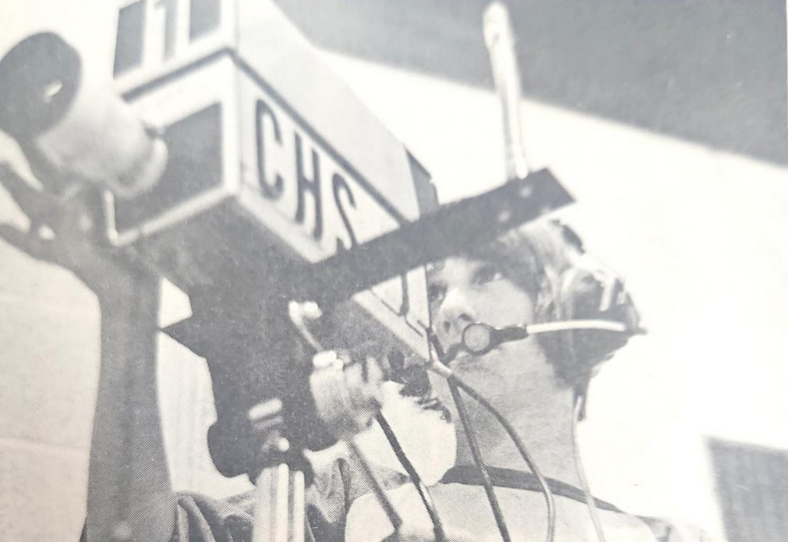
TOM NEIHOFF receives instructions from the director through his headset and frames up a shot.
According to program adviser Paul Wilfahrt, Cathedral originally got into television programming last year as a tool to be used in the classroom.
The equipment, purchased basically through money obtained through student fund-raising, soon became in such great demand that, according to Wilfahrt, the school was forced to buy more equipment to allow for a second unit.
“The idea caught fire on a large scale,” says principal Dave Scheiffert. “It’s very highly regarded as an educational tool.” Although school officials can see several benefits of the program, two off them — its service to general education and the interest it creates for many students — are probably seen as the most important.
…Back upstairs, before the Veterans Day broadcast, Norb Portner who is to help with the audio on the floor during the airing, adjusts the cards that will title the program and label the speakers.
He sets the cards up on a moveable table directly behind the secondary camera in the upstairs booth. During the broadcast, the letters will be superimposed on the screen.
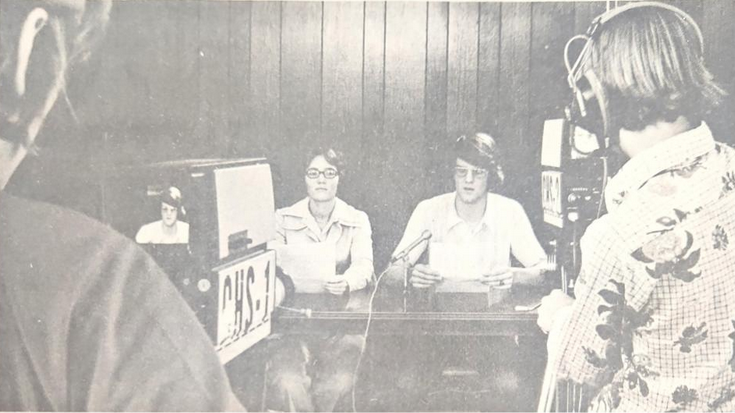
CAMERMAN Steve Wolf (right) and Tom Niehoff confine Jerry Eichten in their viewfinders during the video-taping of “C-Scene” a student news program.
After setting the cards, Portner adjusts a light on the door so that it shines on the bulletin board. Wilfahrt instructs him to place the light to the left of the cards so that construction lines will not show up.
“Obviously, in terms of helping the students,” Scheiffert says, “it gives a lot of students interest in something that is creative, and it also gives them the chance to get involved in a career, to test it.”
“I see this as a real interest builder,” adds Wilfahrt, pointing out that it has helped students who are marginal in school with their entire courseload because they have an interest in one special project.
“You can have a kid who won’t say a word all year in a literature class,” he says, “but he gets into this and all of a sudden he lights up like a light bulb.”
For, according to Wilfahrt’s philosophy, interest is probably the most important factor involved in learning motivation.
“I know from myself that if I have something like this that I’m really interested in, it helps make the rest of the day more exciting,” he says….Meanwhile, it is five minutes to air time, Wilfahrt tells his student staff through a head mike.
“Joel, I believe your first shot will be of the polium; then you’ll have to spin around real fast to get the color guard,” he directs Joe Windler on the floor camera.
He asks Jerry Eichten to give him a combination shot on the monitor set up on a console at the end of the hall on the second floor.
The students move in and the event starts, with the color guard introduced.
“Joel, spin and get the color guard,” Wilfahrt says.
Then he turns his attention to Jane Rieger, handling the camera in the upstairs booth.
“Jane, spin and get the color guard as soon as you can…”
About 30 students are capable of helping with the set up, according to Wilfahrt. About 80 or so can help with the cameras.
The program, he points out, is purely extra-curricular although there is one class at Cathedral called Media Productions in which students learn to write scripts and perform.
Since moving onto the cable, this year, there have been few conflicts with regular classrooms for use of the equipment, Scheiffert says, and Cathedral tries to coordinate its programming as much as possible with that of the public schools.
“I think at this point, since it’s so new, it’s almost impossible to evaluate,” he says. “But if this thing can turn a student on to taking an interest in something in school, then the program has been well worth while.”
…The Veterans Day program comes to an end and Eichten operating the monitor, blends the credits in with the filming of the final speaker on the screen.
“Wrap it up,” Wilfahrt says softly.
The assembly ends.
Without another word from Wilfahrt, students begin unhooking cables, putting away cameras and microphones. In a matter of minutes, the entire operation is cleaned up.
New Ulm Daily Journal
Nov. 25, 1975
- JOHN HOFMEISTER, wearing headset, works with the Special Effects Generator (SEG), while Tom Niehoff watches the audio level. The three small TV monitors are used to view camera shots, one for each of Cathedral’s two cameras, and one for use with the SEG. The shot to be used is then “punched up” onto the larger monitor at the right. All parts are separate components and were built into the console
- TOM NEIHOFF receives instructions from the director through his headset and frames up a shot.
- CAMERMAN Steve Wolf (right) and Tom Niehoff confine Jerry Eichten in their viewfinders during the video-taping of “C-Scene” a student news program.

